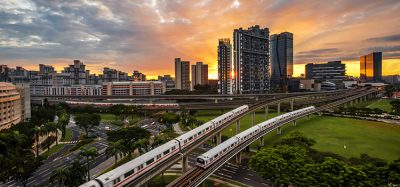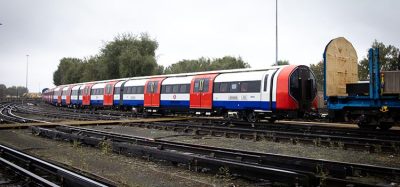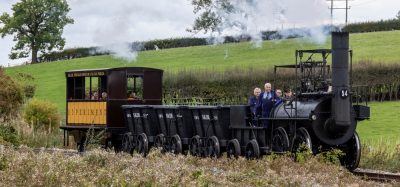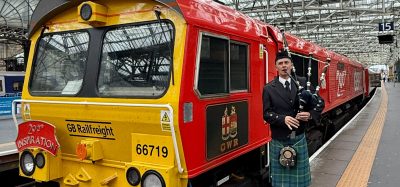The Bothnia Line is built for the future!
Posted: 26 September 2009 | | No comments yet
The Bothnia line consists of 190km of new railway, with 140 bridges and 25km of tunnels. Botniabanan AB has been commissioned by the Swedish government to build the Bothnia Line, a railway running from Nyland, north of Kramfors, via Örnsköldsvik to Umeå. Ground-breaking for the project took place on 14 August 1999 and the railway will become operational in autumn 2010. A big opening is planned to happen on 28 August 2010.
The Bothnia line consists of 190km of new railway, with 140 bridges and 25km of tunnels. Botniabanan AB has been commissioned by the Swedish government to build the Bothnia Line, a railway running from Nyland, north of Kramfors, via Örnsköldsvik to Umeå. Ground-breaking for the project took place on 14 August 1999 and the railway will become operational in autumn 2010. A big opening is planned to happen on 28 August 2010.
The Bothnia line consists of 190km of new railway, with 140 bridges and 25km of tunnels. Botniabanan AB has been commissioned by the Swedish government to build the Bothnia Line, a railway running from Nyland, north of Kramfors, via Örnsköldsvik to Umeå. Ground-breaking for the project took place on 14 August 1999 and the railway will become operational in autumn 2010. A big opening is planned to happen on 28 August 2010.
The Bothnia Line will link together a highly productive region, where a series of significant industrial locations are all situated along the Swedish coastline.
Effective transportation and communication are invaluable. The construction of the railway will enable substantially faster and improved transportation, for both passengers and freight. The Botniabanan AB organisation has solid experience in project and construction management, purchasing, cost control and planning from previous, well-executed, relatively large infrastructure projects for railways, roads and bridges. These projects include the Grödinge Line, the Hälsingekusten project, the Höga Kusten project, the Arlanda Line and Svealand Line.
We are truly looking forward to accomplishing the Bothnia Line project and achieving first-rate results – economically defendable, high quality, environmentally certified and environmentally declared, with relevant technology and high demands placed on safety, working environment, and information.
We are convinced that individual people, as well as companies and economic life in general, will benefit from the investment.
The Bothnia Line is the biggest Swedish railway project of modern times and is being built to meet the future demands for a modern railway and it will act as the arterial route in the region for the transportation of cargo and passengers for a very long time to come. The line has four aims:
- To enlarge the region, which will allow places to work together and supplement on another
- To develop trade and industry all along the coast of Norrland with a view to developing future-oriented trade and industry which is sustainable in the long-term
- To reinform conditions for the development of housing areas and a transport structure which are able to work together
- Good environment and long-term sustainability
BEST – the actual railway
BEST, which is an abbreviation of the Swedish Bana, El, Signal, Tele – is the actual railway; that is to say, the track and line, power supply, the signaling system, telecommunications and safety.
The track and line
The Bothnia Line will be planned and constructed in accordance with the regulations (BVF) and manuals (BVH) issued by the Swedish Rail Administration. Among other things, these regulations control the layout of the track and the standards which it must maintain. Certain facility components must also be approved by the Head Office of the Swedish Rail Administration before they may be used.
The municipalities in the region are responsible for the construction and operation of travel centres and construction of six new travel centres was started during 2009.
The Railway Inspectorate is the authority which will approve the track prior to allowing trains to use it.
The sub-base
Great demands will be made on the track once trains are running on it – both heavy goods trains and express trains travelling at speeds of up to 250kp/h. The sub-base is made up of earth and blasted rock, with a rolling track bedding of macadam.
Sleepers and rails
The railway line itself is built with the help of concrete railway sleepers, flexible supports, and UIC 60. The rails are welded together on the track with thermit welding. The track gauge will be 1435mm, as is the case in most of Europe. On the main line, the points are fitted with a movable point frog.
All-welded track
Temperatures vary greatly between summer and winter in Northern Sweden, which makes it absolutely vital for the allwelded track to be fixed at a specific temperature. If the temperature is not correct during construction, the rail will have to be cut away and loosened and then adapted to the right temperature by extending or shortening it (known as neutralisation).
Twenty or so bridges are fitted with expansion devices at their moving supports in order to absorb longitudinal track and bridge movements.
Cable routing
Concrete cable ducting of various sizes are laid along the Bothnia Line so that cables can be laid simply and protected. Objects are attached to this ducting along the track by means of various types of channels. Where the track has to be crossed with cables, plastic piping is laid through the sub-base at a depth of no less than 1200mm, and this piping is attached to wells on either side of the track.
Power supply
Electricity is needed to run the trains, keep the points free of snow, provide illumination at stations and in tunnels and also for signalling and telecoms equipment. The trains will be run using single-phase 15 000 V power at a frequency of 16 2/3 Hz.
The contact line
The high speeds of the trains will place great demands on the interplay between the contact line and the pantographs on the trains. The contact line is being designed using advanced software.
The contact line is fitted in a ‘zigzag’ shape so as to reduce wear on train pantographs and enhance reliability. The wires are constantly touched above the carbon rail on the pantograph so that wear on this carbon rail is kept as even as possible.
AT system
The Bothnia Line uses an automatic transformer system for the transfer of power in the contact line network. AT transformer systems transfer power at 30 kV, and this power is transformed to 15 kV in special AT transformers after every 10 km.
The AT system is considerably more efficient than the traditional booster transformer system on account of the fact that there are fewer transmission losses.
Electrical safety
Electricity poses an invisible threat, so construction work must be carried out safely. All metallic conductive parts on the railway are fitted with a ground connection, and safety devices are fitted on bridges, etc. Delicate protective systems which rapidly shut down the cables in the event of a fault are fitted at the discharge points.
Work on and alongside the cabling is carried out in accordance with regulations stipulated by the Swedish Rail Administration.
The signalling system
The Bothnia Line signal safety system is built to allow safe, efficient rail services using different types of train travelling at different speeds.
Great emphasis is placed on technical safety, and the signalling system will be adapted so as to increase safety in tunnels and on platforms.
The Bothnia line is being built as a single track with around 20 passing places. The maximum permitted speed will be 250kp/h. Remote control will be provided from Ånge Traffic Management Centre.
The railway is built with a new signalling system called ERTMS (European Rail Traffic Management System). This means there are no visual signals by the railway. Instead, the locomotive driver will get all the information he needs to drive the train direct to a display panel in the locomotive by radio (GSM-R). ERTMS makes it possible to drive trains at over 250kp/h and also increases the capacity of the railway in terms of the number of trains.”
The system must also be simple to maintain and alter once it is complete – these are also important parameters for the project.
Telecommunications and safety
Safety
The Bothnia Line is a modern railway facility with stringent demands as regards safety. A safety policy has laid the foundation for safety work, which includes analysing risks and making decisions on action to enhance safety. These will all be compiled in a safety concept.
A high track standard, ATC and crossings all at different levels are important if we’re to maintain uniform high levels of safety.
The railway passes through a total of 25km of tunnels. Special measures are put into place to prevent trains stopping in tunnels in the event of a fire. In addition, the tunnels are equipped with escape routes, lighting and communications in order to facilitate evacuation should an accident nevertheless occur. The tunnels are also fitted with equipment to help the emergency services in the event of an accident.
Detectors for checking derailment, loading gauge, overheating and wheel faults are installed all along the track.
Measures to enhance safety is considered for fragile environments in the vicinity of the railway.
Telecoms
The Swedish rail system has always needed to communicate in order to ensure greater safety for the traffic using the system. Calls and impulses were initially transmitted via overhead transmission lines and copper tele cables. Nowadays, however, most of the information is transmitted using optical cable and are cast in PCM (Pulse Code Modulation) equipment.
Tele cables
48-fibre optical cables are laid right the way along the Bothnia Line. A large number of tele cables, particularly inside tunnels are also mounted. Copper Optocables are branched off and some 40 technical kiosks.
Telephony systems
Emergency telephones are installed in tunnels at 300m intervals. Service telephones are installed at service stations.
Transmission facilities (PCM)
The transmission network is constructed using SDH technology with a capacity of 155 Mb/sec. In the transmission nodes, tele and data connections are provided for GSM-R, detectors, alarm, traffic control, power management, telephony and information systems.
Radio equipment
A system based on the GSM standard (phase 2+) is constructed along the entire length of the Bothnia Line and be designated GSM-R, where R stands for Railway. GSM-R will also be available in tunnels on the Bothnia Line along with the rescue services’ radio system.
Detectors
Detector equipment is installed along the Bothnia Line in order to detect faults and damage to wagons and locomotives. There are units for the detection of overheating in axles/dragging brakes, wheel damage and one wind warning unit.
Information systems
Information systems are placed in six locations at stations and passenger transfer stops. The system is equipped with speakers, clocks and electronic information displays.
More about ERTMS/ETCS
Level 2 on the Bothnia Line
In Europe, ERTMS projects are underway in, for example, Switzerland, Italy, the Netherlands and Spain. The first line to be equipped with the new system in Sweden is the Bothnia Line. The EU now stipulates that all new lines and all lines that are substantially converted must be equipped with ERTMS. In 2007, The ERTMS system was tested on a 12km-long section between Örnsköldsvik and Husum. On completion, the whole Bothnia Line and the trains operating on it will be equipped with ERTMS/ETCS. Trains operating on the Bothnia Line, and other ERTMS equipped lines, will need to be provided with an adaptor entitled an STM (Special Transmission Module) in order to enable them to travel along lines which have traditional signalling systems. STM units translate information from traditional systems and provide this to the ETCS equipment. STM is under development within Banverket and is a vital ingredient in the ERTMS project for the Bothnia Line.
ERTMS – information via radio
Using ERTMS/ETCS the train receives, via radio signals, all the required information such as speed, braking curves and the situation on the forthcoming section. This information is presented to the driver on a monitor mounted in the drivers cab. ERTMS calculates different braking curves for different types of train. This means that train movements will be more even and that less distance is required between trains. Compared with the traditional Swedish signalling systems, ERTMS is clearly more flexible and advanced with regard to conveying information. Present-day systems are based on visual signals whereby the train driver receives information via light signals which indicate how fast the train may proceed together with certain information on the approaching section. This leads to a particular limitation: the higher the train speed, the less ocular information can be registered by the driver. To alleviate this problem optical signals are supported by, the Automatic Train Control (ATC) system. Balises along the track send signals to the train driver containing the same information as the light signals. If the ATC system sends signals to brake and the driver fails to brake, the system intervenes and applies the brakes. The ERTMS system also utilises balises. In ERTMS Level 2 their only function is to update the locomotive’s position information.
Important events
Throughout 2008, many important events were realised. In February 2008, commencement of goods traffic on a few kilometres of the Bothnia Line began when the Swedish Rail Agency permitted BAE Systems Hägglunds AB to run rolling stock on ‘track under construction’. In March 2008, support for the Bothnia Line reached an all-time high, when 81% of those asked in an opinion poll said that they felt positive about the project. In October 2008, Botniabanan AB and the Swedish Rail Administration signed a contract for the leasing of the Bothnia Line and also in the same month, in accordance with the framework agreement, Stage 1 was handed over to the Swedish Rail Admininstration and goods traffic started on the Örnsköldsvik-Husum section.
In June 2009, high-speed tests were executed with a passenger train on 60km of the southern part of the Bothnia Line in purpose to test the interior fixtures of the long tunnels at a speed of 275km/h. In order to keep the limited test-speed on the section, the train was driven at a top-speed of 289km/h. The tests all gave a satisfactory result to make sure that the line will stand up to the load of commercial traffic.
Bridges
The Bothnia Line is being constructed for a maximum train speed of 250km/h. This has placed particular requirements on, for example, the design of bridges.
The Swedish Rail Administration currently has no load conditions relating to lines with such high speeds. In addition to the normal strength calculations, all bridges have been analysed for the special dynamic traffic loads that may arise. These loads have, in certain cases, resulted in bridges being designed with a cross section that is slightly different from normal. This is so as to avoid unnecessary wear of bridge structures.
Of course, track, electrical and signalling systems for high-speed lines also require more complex analysis.
Current construction
The remaining construction work is on the north of the line, 30km south of the town Umeå. The 2km-long bridge over the river Umeälven is being completed – the last 30 metres were casted in August. During the following autumn, track will be laid on the last section and during the winter the contact line and power supply will be installed as well as cables for telecommunications and the signaling system.
In October 2009, the southern part between the towns Kramfors and Örnsköldsvik will be handed over to the Swedish Railway Administration. Though completed, the line will not be operated until autumn 2010 because of the delayed construction of the Ådal Line between the towns Kramfors and Sundsvall.
In April/May 2010, there will be new high-speed tests of the northern part of the railway and on 28 August 2010, there will be a grand opening of the Bothnia Line.
Handover
“We have now entered the project’s final phase – handover,” says Alf Karlsson, Manager of the Handover subproject. He continues, “This is where the company’s various subprojects hand over coordination responsibility, construction responsibility, management data, training documentation, company documentation and, as evidence that the technical requirements placed on the facilities have been met, verificatory documentation. With documentation as the base, the company applies to the Swedish Transport Agency for technical approval. The management data is the documentation necessary for future maintenance of the line.”
Mr. Karlsson continues, “After the line has received technical approval from the Swedish Transport Agency, and the management data has been handed over to the Swedish Rail Administration, the Swedish Rail Administration takes over the line for commercial traffic. Until the Swedish Rail Administration takes over the line, it is managed by Botniabanan AB’s infrastructure management function. The line is being handed over in three stages. Stage 1 was handed over in October 2008. Stage 2 is being handed over in October 2009 and the final stage in August 2010.”
Global Railway Review Autumn/ Winter Issue 2025
Welcome to 2025’s Autumn/ Winter issue of Global Railway Review!
The dynamism of our sector has never been more apparent, driven by technological leaps, evolving societal demands, and an urgent global imperative for sustainable solutions.
>>> Read the issue in full now! <<<







